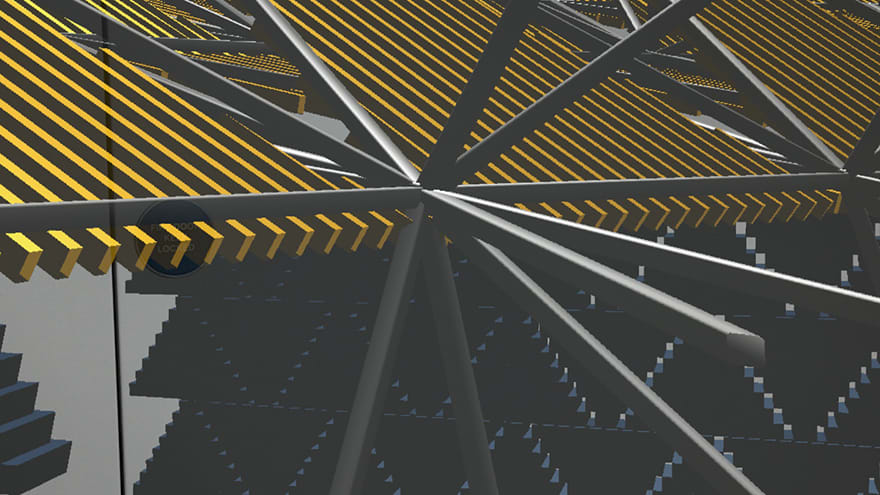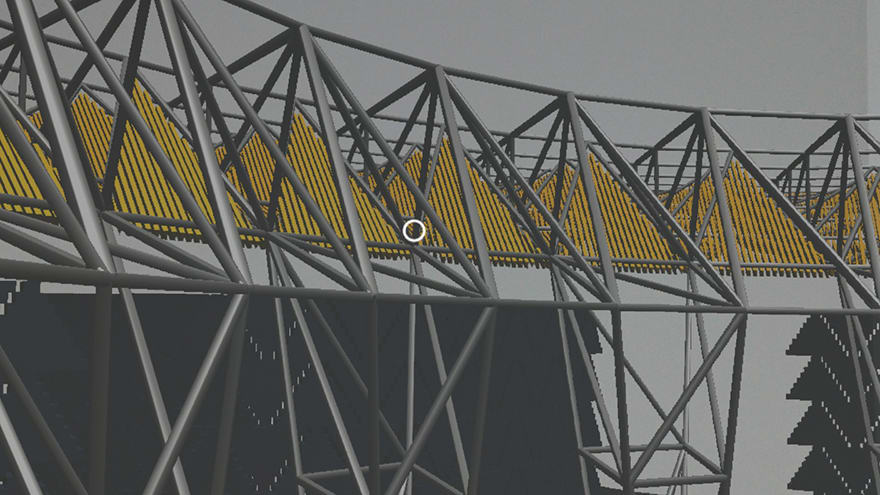Virtual and augmented reality technologies were critical to the design of this year’s Serpentine Pavilion, by African architect Francis Kéré.
The installation, which opens to the public in London’s Kensington Gardens this weekend, was inspired by a large tree in Kéré’s native village of Gando, Burkina Faso, a central meeting point for the community.
It features a 25m-diameter timber roof that slopes inwards to form a conical funnel where rain is channelled into a circular waterfall. The roof appears to hover above four curving timber walls, which are stained dark blue and set out in a staggered pattern of triangles.
Augmented reality simulations of the scheme, viewed in Microsoft HoloLens, were used daily throughout the project to develop early concepts and review details for things such as bolted connections and welds.
This is the second year Hololens has been used on the Pavilion, last year it was deployed at critical points, this year it has been a permanent fixture in the design process.

Designers donned HTC Vive virtual reality goggles to view fully rendered and photo-realistic models of the Pavilion.
Jon Leach, director for buildings and places at Aecom, which provided engineering and technical services for the project, told BIM+: “HoloLens has really helped us resolve the complex 3D geometry, such as making sure the modules for the timber walls stacked up correctly.
“As the walls curve the contact area between modules reduces so we had to make sure it worked. It is easy to manipulate the model, you simply place it in front of you with finger gestures and physically move around it.”
HoloLens was used mostly to interrogate smaller models and component-level reviews, where the native geometry could be imported into the hardware quickly with no need for post-processing. When more complex models had to be displayed, a series of scripts were run to clean them up and optimise them.
“We have evolved our workflows so the model can be updated as necessary and reimported almost instantly. We frequently use a multi-user environment and a combination of multiple headsets and screens to carry this out,” says Leach.

Augmented reality simulations of the scheme, viewed in Microsoft Hololens, were used daily throughout the project
Designers, including Kéré himself, donned HTC Vive virtual reality goggles to view fully rendered and photo-realistic models of the Pavilion. Realistic lighting helped identify areas of the roof canopy where the steelwork structure was out of alignment with the timber and the best locations for bolted connections and splices to suit the aesthetics.
According the Leach, changes to the VR model – developed in a combination of Rhino and 3D Studio Max software – could be made fast enough to run them in HTC Vive during a design review meeting. However, getting the best visual quality for presentation material “takes hours or often days”.
Leach envisions a future were AR and VR technologies start to merge, for example sharing the same native geometry. “I don’t think that’s very far away, but first we need the industry to focus more on making these tools useful for rapid design iteration and not just for high quality end-products for marketing,” he concludes.
The Serpentine Pavilion can be seen at the Serpentine Gallery, London, from 23 June to 8 October.
We have evolved our workflows so the model can be updated as necessary and reimported almost instantly. We frequently use a multi-user environment and a combination of multiple headsets and screens to carry this out.– Jon Leach, Aecom













